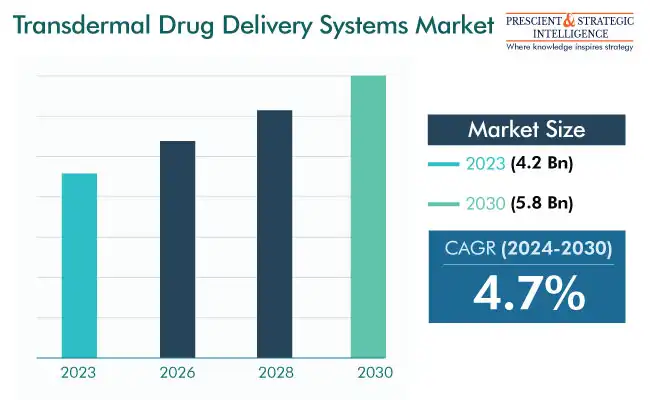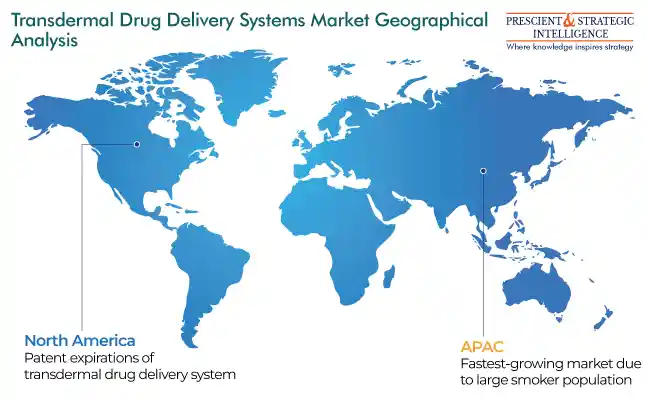Report Code: 11380 | Available Format: PDF
Transdermal Drug Delivery Systems Market Research Report: Size, Share, Key Trends, Growth Drivers, Regional Outlook, Revenue Estimation and Forecast, 2024-2030
- Report Code: 11380
- Available Format: PDF
- Report Description
- Table of Contents
- Request Free Sample
Market Overview
The transdermal drug delivery systems market was valued at USD 4.2 billion in 2023, and it will grow at a rate of 4.7% during 2024–2030, to reach USD 5.8 billion in 2030.
The industry is mainly propelled by the growing occurrence of chronic illnesses for which a conservative drug delivery system as a weaker effect than needed because of hepatic first-pass metabolism. This means that when most oral drugs enter the liver, they are digested to a large extent before they reach the targeted tissue, thus leading to inadequate efficacy.

The effective nature of such devices can be credited to their advanced drug diffusion abilities over conservative routes of medication delivery, specifically nasal, oral, and intravenous. Moreover, a substantial contributor to the industry development is the growing leaning of patients and doctors toward painless medicine delivery. The oral route can be challenging for people who are unable to swallow due to a disease. Injections, on the other hand, are painful for a lot of people, especially children.
Furthermore, the adoption of transdermal systems helps develop a feeling of self-dependence in patients, through a substantial decrease in the need for hospital visits. This also helps tackle the increasing treatment expenses, especially for the elderly and those not so financially fortunate.
The market is also driven by the technological breakthroughs in drug delivery, notably the integration of mechanical arrays or microneedles into transdermal patches. The progress also includes pressure-sensitive adhesives and permeation enhancers, thereby leading to improved drug diffusion and a higher reservoir capacity for higher drug volumes.
Growing Occurrence of Chronic Diseases Drives Industry Development
The surge in the geriatric populace has significantly advanced the need for medicines. Transdermal drug delivery systems help in administering the medication in a precise manner; thus, the count of patients with chronic illnesses, such as arthritis, heart disease, and diabetes, drives the market.
This is because such chronic illnesses are the leading factor for disability, thereby diminishing people’s ability to visit a doctor frequently.
Such factors have, therefore, augmented research and development activities aimed at improving medicines' efficiency. For instance, studies have shown transdermal chemotherapy to be effective in certain highly localized skin and breast tumors. Furthermore, knowledge among patients about the benefits of the transdermal approach over other drug delivery methods continues to propel the market.
Rising Incidence of Tobacco Smoking
Over a billion people in the world smoke cigarettes, with prevalence continuing to be high despite stronger surveillance, educational, and supply restriction efforts on the national and international levels. This factor is a key market driver as transdermal nicotine patches have been highly popular for ages. As per reports, compared to a placebo administered over a year, nicotine patches have 50–60% higher success rates in helping people quit cigarettes.
Iontophoresis Category Is Dominating the Market
The iontophoresis category is leading the industry, on the basis of technology. This approach has been recognized to advance skin penetration and improve the rate of release of medicines that display poor absorption or permeation inside the body.
| Report Attribute | Details |
Market Size in 2023 |
USD 4.2 Billion |
Revenue Forecast in 2030 |
USD 5.8 Billion |
Growth Rate |
4.7% CAGR |
Historical Years |
2017-2023 |
Forecast Years |
2024-2030 |
Report Scope |
Market Trends, Drivers, and Restraints; Revenue Estimation and Forecast; Segmentation Analysis; Impact of COVID-19; Companies’ Strategic Developments; Market Share Analysis of Key Players; Company Profiling |
Explore more about this report - Request free sample
Microporation Category Is To Advance with Significant Pace
During the projection period, the microporation category is projected to advance at a significant pace. The growing count of product introductions by prominent market players and the fact that several experimental products have demonstrated positive results will drive this category.
For instance, in November 2023, researchers at UCSD published a study on dissolving microneedles for long-lasting pain relief, highlighting their potential for future commercialization. Similarly, in September 2022, Emissia secured USD 44 million in funding to accelerate its microneedle patch development process for insulin delivery, aiming for clinical trials in early 2024. Moreover, in October 2020, the Food and Drug Administration accepted microneedle patch Zipsor (lidocaine) for pain relief.
Pain Management Category Holds Largest Market Share
The pain management category holds the largest market share within the application segment. This is mainly because of the growing incidence of chronic pain due to arthritis, amputations, nervous system disorders, and other conditions. As per estimates, 20% of the adult population on earth is a victim of long-term pain. Chronic pain is a major reason for lost productivity and added emotional and psychological trauma, which is why transdermal analgesia is gaining increasing popularity.
The CNS category holds the second-largest share, credited to the increasing occurrence of neurological illnesses worldwide. For example, the Pan American Health Organization says that in the U.S., 8.2 million years of life lived due to disability are a result of neurological syndromes.
The cardiovascular category is projected to advance at a substantial CAGR during the projection period. This can be credited to the growing usage of such systems for treating hypertension, congestive heart failure, and angina pectoris. For example, the usage of clonidine, isosorbide dinitrate, and nitroglycerin transdermal systems for hypertension treatment has been confirmed to be extremely effective in the complex and uncomplicated phases.
North American Region Is Leading the Market
The North American region is leading the transdermal drug delivery systems industry. The development in this continent is primarily propelled by patent expirations, which are allowing more businesses to enter the industry with generic variants of these devices. Furthermore, the relaunch of formerly failed drugs for subcutaneous delivery and the enormous expenditure by the market players on related R&D are major reasons for the significant share seized by this continent.
Moreover, the favorable insurance scenario and awareness creation efforts by government establishments propel the market in Europe. The region’s sophisticated healthcare infrastructure and the strong government focus on public health propel the market as well. Further, the continent is home to many key medical device and R&D institutions, which leads to the rapid adoption of advanced healthcare technologies.

During the projection period, the Asia-Pacific industry is projected to showcase the highest CAGR. This can be credited to the rising healthcare expenditure and quickly developing healthcare infrastructure, as a result. Furthermore, the high R&D funding and the rising awareness of this drug administration approach in China and India, drive the market. Further, APAC has the largest population of diabetics and tobacco smokers, both of whom are key users of transdermal drug delivery devices.
Transdermal Drug Delivery Devices Companies
- Novartis AG
- Johnson & Johnson Services Inc.
- Viatris Inc.
- Boehringer Ingelheim GmbH
- Biogel Technology Inc.
- Transdermal Technologies Inc.
- Skyepharma
- Watson Pharmaceuticals Inc.
- 3M Company
- Noven Pharmaceuticals Inc.
- 4P Therapeutics LLC
- Transdermal Corporation
- Echo Therapeutics Inc.
- Hisamitsu Pharmaceutical Co. Inc.
- GSK plc
- UCB S.A.
Want a report tailored exactly to your business strategy?
Request CustomizationWant an insight-rich discussion with the report author?
Speak to AnalystOur dedication to providing the most-accurate market information has earned us verification by Dun & Bradstreet (D&B). We strive for quality checking of the highest level to enable data-driven decision making for you
Our insights into the minutest levels of the markets, including the latest trends and competitive landscape, give you all the answers you need to take your business to new heights
With 24/7 research support, we ensure that the wheels of your business never stop turning. Don’t let time stand in your way. Get all your queries answered with a simple phone call or email, as and when required
We take a cautious approach to protecting your personal and confidential information. Trust is the strongest bond that connects us and our clients, and trust we build by complying with all international and domestic data protection and privacy laws